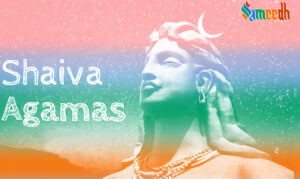The Karana Agama is an ancient Hindu scripture belonging to the Agama category, primarily focusing on rituals, temple construction, and worship practices, particularly within the Shaiva tradition.

The history of the Karna Agama is rooted in the broader tradition of Agama literature within Hinduism. Agamas are a category of scriptures that primarily deal with temple construction, rituals, worship, and spiritual practices. They are considered to be revelations from the divine, typically attributed to specific gods or goddesses imparting knowledge to their devotees. The Karna Agama specifically focuses on these aspects within the Shaiva Agama tradition.
While precise historical records regarding the Karna Agama’s origins and development are scarce, it is believed to have been composed over centuries through the process of oral transmission and later codification. The text itself is traditionally ascribed to Lord Shiv, who is regarded as the primary deity of Shaivism.
The term “Karna Agama” derives from the Sanskrit word “Karna,” meaning “ear,” signifying that it was directly heard by Lord Shiv and subsequently passed down to his devotees. According to Shaiva tradition, Lord Shiv revealed the Karna Agama to a select group of rishis (sages) for the benefit of humanity.
Over time, the teachings of the Karna Agama were systematized and organized into a comprehensive scripture, comprising detailed instructions on temple architecture, deity worship, rituals, and spiritual practices. These teachings were transmitted orally by generations of priests and scholars and eventually committed to writing, likely during the medieval period.
The Karna Agama, along with other Agamas, played a crucial role in shaping the religious and cultural landscape of Shaivism, particularly in South India, where Shaiva temples and traditions flourished. It provided a framework for temple construction, ritual worship, and spiritual devotion, guiding devotees in their religious practices and fostering a deep sense of connection with the divine.
The Karana Agama, an ancient Hindu scripture within the Agama tradition, plays several important roles within Hinduism, particularly in the Shaiva sect. Here are some of its significant roles:
- Guidance for Temple Construction: The Karana Agama provides detailed instructions and principles for the construction of temples dedicated to Lord Shiv. It includes guidelines on architectural design, layout, dimensions, materials, and consecration rituals. By following the teachings of the Karana Agama, devotees ensure that temples are built according to sacred principles, creating spaces conducive to worship and spiritual practice.
- Preservation of Rituals and Worship Practices: This scripture serves as a repository of rituals and worship practices specific to Shaivism. It outlines various rituals, ceremonies, and daily worship procedures to be performed in temples, ensuring the continuity and preservation of traditional Shaiva rituals. The Karana Agama thus plays a crucial role in maintaining the authenticity and sanctity of Shaiva worship traditions.
- Establishment of Sacredness: Through its guidelines for deity installation (prana-pratishtha) and consecration rituals, the Karana Agama facilitates the establishment of sacredness within temple spaces. These rituals are believed to invoke divine presence into the installed deities, sanctifying the temple and creating a spiritually charged atmosphere conducive to worship and meditation.
- Spiritual and Philosophical Guidance: Alongside its focus on temple rituals and construction, the Karana Agama may also contain teachings on spirituality and philosophy. It may provide insights into the nature of the divine, the relationship between the individual soul (jiva) and the universal consciousness (Shiv), and the path to spiritual liberation (moksh). By imparting spiritual wisdom, the Karana Agama guides devotees on their journey towards self-realization and union with the divine.
- Cultural Significance: As an ancient scripture, the Karana Agama holds cultural significance within the Shaiva community. It serves as a source of inspiration, guiding devotees in their religious practices, fostering a sense of community, and preserving the rich heritage of Shaiva traditions. The teachings and practices outlined in the Karana Agama contribute to the cultural identity and spiritual vitality of Shaivism.
In summary, while the precise historical timeline and authorship of the Karna Agama remain unclear, it represents an essential aspect of Shaiva tradition and continues to influence temple rituals and spiritual practices within the broader Hindu community. Its teachings remain relevant and revered by devotees seeking to honor Lord Shiv and engage in authentic Shaiva worship.
Overall, the Karana Agama plays a multifaceted role in shaping Shaiva religious, spiritual, and cultural practices. It serves as a guidebook for temple construction, deity worship, and spiritual growth, enriching the lives of devotees and fostering a deeper connection with the divine.